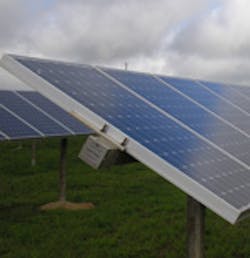La Ola Solar Farm
Researchers from Sandia National Laboratories have developed a system that monitors how clouds affect large-scale solar photovoltaic (PV) power plants. By observing cloud shape, size, and movement, the system enables utility companies to predict and prepare for fluctuations in power output due to changes in the weather. These models also will give these companies valuable data to assess potential power plant locations, ramp rates, and power output, Sandia says.
The researchers are focused on the 1.2-MW La Ola Solar Farm on the Hawaiian island of Lana’i, which is the state’s largest solar power system. It can produce enough power to supply up to 30% of the island’s peak electric demand, which is one of the highest rates of solar PV power penetration in the world. According to Sandia, understanding the variability of such a large plant is critical to ensuring that power output is reliable and that output ramp rates remain manageable.
“As solar power continues to develop and take up a larger percentage of grids nationwide, being able to forecast power production is going to become more and more critical,” said Chris Lovvorn, director of alternative energy at Castle & Cooke Resorts LLC, which owns 98% of the island. “Sandia’s involvement and insight has been invaluable in our efforts to meet 100% of the island’s energy needs with renewable resources.”
While the effects of clouds on small PV arrays are well documented, Sandia says, there is little research on how large-scale arrays interact and function under cloud cover. A small system can be completely covered by a cloud, drastically reducing its power output. But what happens when only part of a large system is covered by a moving cloud shadow while the rest stays in sunlight?
“Our goal is to get to the point where we can predict what’s going to happen at larger-scale plants as they go toward hundreds of megawatts. To do that, you need the data, and the opportunity was available at La Ola,” said Sandia researcher Scott Kuszmaul.
Combined with the sun and cloud mix at the La Ola plant, the high penetration of PV power on Lana’i provides an optimal environment for prediction and modeling research, Sandia says. The research could not interfere with the ongoing operations of the plant, though, which sells power to the Maui Electric Company.
So, Sandia engineers connected 24 small, nonintrusive sensors to the plant’s PV panels and used a radio-frequency network to transmit data. The sensors took readings at one-second intervals to provide researchers with unprecedented detail about cloud direction and coverage activity. Also, the radio-frequency transmission is portable.
“Currently, a utility company that wants to build a large solar PV power plant might have a lot of questions about the plant’s output and variability at a proposed site. Work being done at the La Ola plant is leading to new methods that eventually can be used to answer these questions,” said Sandia researcher Josh Stein. “These techniques will allow a developer to place a sensor network at a proposed site, make measurements for a period of time, and use that to predict plant output variability.”
Castle & Cooke Resorts LLC and SunPower Corp., which manufactures high-efficiency solar cells, commissioned La Ola in December 2008. The project uses SunPower’s Tracker technology, which uses panels that rotate on a single axis to follow the sun and increase energy capture by up to 25%.
Since February, Sandia Labs has held a cooperative research and development agreement with SunPower to conduct research on integrating large-scale PV systems into the grid. The agreement is funded with about $1 million of combined U.S. Department of Energy and SunPower funding. The partners expect to achieve significant results that will be disseminated through joint publications over the next two years.
About the Author
Staff
Articles, galleries, and recent work by members of Electronic Design's editorial staff.
